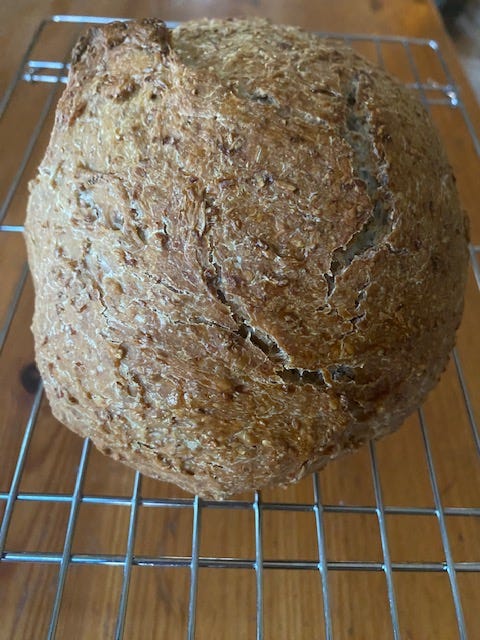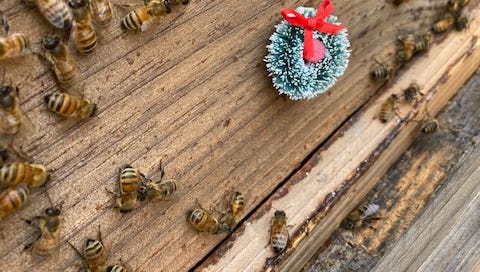How our winter lifestyle mirrors honey bees in winter
I noticed that a lot of the seasonal parts of our life look like the social practices in a honey bee colony.
We’re in the season that has become the most restful and least hectic time of the year for me. The garden is essentially in slow motion with the cold temperatures and shorter days. Our layer chickens don’t free range as often due to higher hawk pressure. The quail covey doesn’t lay eggs fall through winter, so they essentially freeload until spring. The honey bee colonies are tucked in for winter and I won’t inspect them until after the New Year.
The extra time that’s bubbled up from the slowing down and pausing of all things gives me time indoors. It inherently prompts me to be more reflective on life and our home. I realized many of my seasonal routines in winter look similar to how the bees change their lifestyle in this season.
1. Heat
Me: Sauna time. I half-joke that the reason I regularly go to the sauna throughout the winter is to keep my body primed for summer hive inspections. Although I do think it helps, I really go because it feels good. A 2018 article in Evidence-Based Complementary and Alternative Medicine found there are many health benefits to dry sauna bathing, but it also found that more research is necessary to identify how long and how often would be most beneficial. As outside temperatures start to drop, my gym time increases. I try to visit the sauna 2-to-3 times each week all winter long and stay in the sauna for as little as 10 minutes if I’m pressed for time, but usually up to 30.
Bees: Cluster. While my sauna visits are more self-care motivated, honey bees cluster all winter to keep the queen alive. The center of the cluster where the queen is sheltered remains 90F to 100F even on the coldest nights. While many worker bees die off in the cold during this season, as long as the queen is cared for and kept alive, she’ll lay eggs in the New Year and build the colony up quickly.
2. Steam
Me: Facial steams. For as long as I can remember I’ve managed dry skin, which is worst in winter. A few years ago I read about herbal facial steams. You boil a small amount of water in a pot. As soon as it starts to boil, drop in fresh herbs and cover the pot. Set the pot up on a chair, uncover, and drape a towel over your head and the pot. Use the utmost care to keep your face a safe distance from the steam and don’t open your eyes. I set a timer for 10 minutes. I usually do this before a bath or shower, and then apply coconut oil or a lard- or tallow-based moisturizer. I truly feel like a million bucks after one of these little steams.
Bees: Moisture control. Yes, the bees aren’t giving each other facial steams. They do, however, need to manage moisture. They can’t have too much of it because cold temperatures and moisture equal death.
3. Nutrition
Me: Citrus orders. I learned about an orange farm in California from my friend and TLT subscriber Sarah Anne. She orders oranges throughout the winter from the farm, a tradition I started a few years ago. I love having the fresh oranges for juices, snacks, cocktails and mocktails. I use the juice in my winter wassail, and dry skins and dip them in sugar and chocolate for candied orange peel treats for myself and gifts for others. I love the support of the extra fiber and Vitamin C during the darkest months of the year.
Bees. Pantry picking. While the bees aren’t foraging from far-off places in winter, they do have pollen and nectar reserves from their foraging flights that prepped them for winter. I like to remind folks that sugar has absolutely no nutrional value—it only provides energy. Honey has many nutritive properties that vary by plant source. The bees get to pick through their honey pantry all winter, moving to different reserves in the hive on warmer days. All of those stored food sources provide a variety of health support during a tough season.
4. Purging
Me. Thrift runs. The extra time indoors makes me notice things we may not need or that don’t fit my taste anymore. The majority of our home décor is thrifted, so very few things were costly to acquire. I do a few donation drops at thrift shops during the winter. I like to think that it makes space for better things to come into our life.
Bees. Cleansing flights. The bees’ version of this purging is more biological. Honey bees don’t defecate in the hive. Since the bees are busy keeping the queen warm in the winter, they can only leave the colony for cleansing flights on the warmest days. Also, some bees on the outer fringes of the cluster will die. Surviving bees act as funeral directors and pick up the dead bodies and carry them out of the hive. Another act of purging for the bees, which they don’t do themselves, is comb removal. Each winter I cut out all comb that’s 5 years old. The empty frames go back to the bees in the next season so that they can build fresh comb in them. Removing the old comb removes potential pathogens, spores, and pesticide buildup that may have happened over the years. This helps prevent colony health issues and also helps preserve honey flavor.
There are some aspects of my winter lifestyle that I don’t see mirrored with the bees. I love baking bread in this season. I might bake a little in the summer, but winter is the prime time for my breadbaking. The spring and summer demands of the garden and bees challenge me to keep a sourdough starter healthy, and summertime heat doesn’t motivate me to run the oven more than necessary. Sourdough research published in 2022 in Advances in Nutrition found “significant improvements were observed in parameters related to glycemic response, satiety, or gastrointestinal comfort after bread ingestion.” I also have bone broth simmering on rotation throughout the winter, so the combination of fresh bread and soup is a simple snack or meal. The bees aren’t curating meals this time of the year—although they do to some degree when they make “bee bread” for brood in warmer months.

Another focus in the winter is adding and removing species from the landscape. My latest heirloom apple and pear tree order arrived. A few of the apple trees I planted in 2020 died last winter, so I’m replacing them and also adding other varieties. As for invasives, we have a tremendous number of autumn olives (autumnberries, Elaeagnus umbellata) in the understory of our woods. Yes, these are a good food source for wildlife and also for human consumption, but they choke out native species. I’ve been slowly working my way through the woods each year thinning out the autumn olives. Last year I saw even better improvement in removing them by rotating the pigs through those areas.
Overall the biggest similarity between honey bees’ winter life and our own is staying home and inside. We’re all waiting for the season to pass and for the world to wake up again.




